Reflection Propagation Law of Electromagnetic Waves in U-Shaped Roadway
Abstract
1. Introduction
2. Mirror Image Method
3. U-Shaped Roadway Model and Reflection Path Validity
3.1. Valid Mirror Points
3.1.1. Mirror Point Calculation
3.1.2. Mirror Point Evaluation
- (a)
- The reflection point is located on the line connecting the mirror and reception points and intersects with the reflection plane (except for the boundary of the reflection plane).
- (b)
- The lines connecting the reflection point to the transmitting point, the reflection point, the relay node, and the receiving point cannot be obscured by the plane m4, the plane m5, and the plane m6.
- (c)
- When propagating in a straight roadway, the reflection point is valid if conditions a and b are satisfied.
- (d)
- The ray emitted from the emitting point needs to pass through the relay node, from which it is emitted to reach the reflecting surface, and the reflecting point is valid if condition a and condition b are satisfied.
3.1.3. Reflecting Surfaces Boundary Evaluation
3.1.4. Reflection Point Calculation
3.2. Reflection Path Validity
3.2.1. Four-Time Valid Reflection Paths
- (a)
- Create a primary mirror image of the emitting point T with respect to plane m1 and obtain the primary mirror point I1.
- Set point I1 as the base point, create a secondary mirror image in plane m2, and obtain a secondary mirror point I12.
- Connect point I12 with point P, and the intersection point of plane m2 is A12.
- Connect point A12 with point I1, and the intersection point of plane m1 is point A1.
- Points T, A1, and A12 are connected sequentially to form a secondary valid reflection path.
- (b)
- A primary mirror of relay node P is made with respect to plane m5 to obtain the primary mirror point I5, and a secondary mirror in plane m2 is made based on this point to obtain the secondary mirror point I52.
- Connecting point I52 with point R, the intersection point in plane m2 is A52.
- Connecting point A52 with point I5, the intersection point in plane m5 is A5.
- The connecting points P, A5, A52, and R form a secondary valid reflection path in that order.
3.2.2. Five-Time Valid Reflection Paths
- (a)
- The emitting point T is first mirrored with respect to plane m1 to obtain the first mirror point I1.
- Set I1 as the base point; T is mirrored in plane m2 to obtain the second mirror point I12, which is connected to point P.
- The intersection of plane m2 is B12; point B12 is then connected to point I1, and the intersection of plane m1 is B1.
- By connecting the points T, B1, and B12 sequentially, a secondary valid reflection path was formed.
- (b)
- Mirror relay node P with respect to plane m5 for one level and obtain the first-level mirror point I5.
- Set I5 as the base point, mirror it on plane m2 for two levels, and obtain the second-level mirror point I52.
- I52 is then used as the base point, mirroring it in plane m3 for three levels and obtaining the third-level mirror point I523; connect point I523 with point R.
- The point of intersection in plane m3 is B523; connect the point B523 with to point I52.
- Finally, connect the point B52 with point I5, and the intersection in plane m5 is B5.
- Points B523 and I52 are connected to the point of intersection B52 in the plane m2.
- Finally, B52 and I5 are connected in plane m5 intersection for B5; sequentially connected points P, B5, B52, B523, and R form a tertiary valid reflection path.
3.2.3. Six-Time Valid Reflection Paths
- (a)
- Create a primary mirror of the emission point T with respect to plane m1 to obtain the primary mirror point I1.
- Set I1 as the base point, and a secondary mirror is made in plane m2 to obtain the secondary mirror point I12.
- Connect point I12 with point P, and the intersection point of m2 in the plane is C12.
- Connect the point C12 with point I1, and the intersection point m1 in the plane is C1.
- Connect points T, C1, and C12 in turn to form a secondary valid reflection path.
- (b)
- Relay node P is mirrored with respect to plane m5 to obtain the first-level mirror point I5.
- With I5 as the base point, it is mirrored in plane m2 to obtain the second-level mirror point I52.
- With I52 as the base point, it is mirrored in plane m3 to obtain the third-level mirror point I523.
- Finally, with I523 as the base point, it is mirrored in plane m6 to obtain the fourth-level mirror point I5236.
- The I5236 point and R point connection in plane m6 intersect at C5236.
- The C5236 point and I523 point are connected to the plane m3 intersection for C523.
- The C523 point and I52 point are connected to the plane m2 intersection for C52.
- Finally, points C52 and I5 are connected to the plane m5 intersection for C5.
- Sequentially connect points P, C5, C52, C523, C5236, and R.
- Points P, C5, C52, C523, C5236, and R form a quaternary valid reflection path.
4. Reflected Field Strength Calculation
4.1. Incidence Angle, Path Length, and Reflection Coefficient
4.2. Reflected Field Strength
5. Simulation Analysis
5.1. Number of Effective Reflection Lines
5.1.1. Distance from Sending/Receiving Points to Corners
5.1.2. Sending and Receiving Points Location
5.2. Reflected Field Strength at Receiving Point
5.2.1. Relay Node and Receiving Point Location
5.2.2. Antenna Frequency
5.2.3. Relative Permittivity of Roadway Walls
5.2.4. Impact of Roadway Width
6. Analyses of Simulation Experiments
6.1. Location Analysis Between Relay Node and Receiving Point
6.2. Antenna Emission Frequency Analysis
6.3. Analysis of the Relative Dielectric Constant of the Roadway Walls
6.4. Roadway Width Analysis
7. Conclusions
- (1)
- The distance from the transceiver point to the corner and the position of the transceiver point in the U-shaped roadway affect the number of valid reflection lines. When the distance from the transceiver point to the corner decreased, the number of valid reflection lines increased, and the change in the vertical position had a relatively small effect on the number of valid reflection lines compared to the change in the horizontal position of the transmitting point. When the transceiver point is located in the center of the roadway, it facilitates electromagnetic wave propagation.
- (2)
- The distance and height between the relay node and the receiving point in the U-shaped roadway affected the reflected field strength at the receiving point. As the distance between the relay node and the receiving point increased, the reflected field strength of the receiving point decreased, and the attenuation of the reflected field strength at the same height was less than that at the same height when the relay node and the receiving point was not at the same height.
- (3)
- The frequency of the antenna in the U-shaped roadway, the relative dielectric constant of the roadway walls, and the roadway width all affect the reflected field strength at the receiving point. As the distance between the relay node and the receiving point increases, the reflection field strength attenuation at the receiving point will decrease with a larger roadway width, a smaller relative permittivity of the roadway walls, and a lower transmitting frequency of the antenna.
Author Contributions
Funding
Institutional Review Board Statement
Informed Consent Statement
Data Availability Statement
Conflicts of Interest
References
- Jia, Q.R.; Che, D.F.; Zhong, R.Q. Component-based 3D Modeling Method for Complex Mine Roadway Network. J. Northeast. Univ. (Nat. Sci. Ed.) 2020, 41, 1774–1780. [Google Scholar]
- Liu, S.L. Simulation Analysis of Electromagnetic Wave Propagation Characteristics in Mine Roadways. Master’s Thesis, Shandong University of Science and Technology, Qindao, China, 2020. [Google Scholar]
- Yao, S.H.; Wu, X.L.; Zhang, L. Influence of Roughness of Mine Roadway Walls on Electromagnetic Wave Propagation Loss. J. Hefei Univ. Technol. Nat. Sci. Ed. 2010, 33, 4. [Google Scholar]
- Sun, J.P.; Zhang, G.M. Analysis Method of Mine Electromagnetic Wave Based on Hybrid Ray Tracing. J. China Coal Soc. 2022, 47, 2834–2843. [Google Scholar]
- Yang, R.K.; Li, Q.Q.; Yao, R.H. Multiple Scattering and Attenuation of Electromagnetic Waves in Dusty Atmosphere. Acta Phys. Sin. 2016, 65, 98–104. [Google Scholar]
- Zhang, H.L.; Xiong, T.X. Abnormal Reflection and Refraction of Electromagnetic Waves in Biaxial Left-handed Medium. J. Sichuan Norm. Univ. Nat. Sci. Ed. 2010, 2010, 4. [Google Scholar]
- Yang, S.; Liu, L.H. Study on Electromagnetic Wave Transmission Characteristics in Roadways. Laser J. 2014, 35, 2. [Google Scholar]
- Chen, N.; Cheng, L.F.; Zhang, W.J.; Jiao, X.L. Impact of Antenna Beamwidth on Electromagnetic Wave Propagation Characteristics in Roadways. Sens. Microsyst. 2022, 41, 47–50+53. [Google Scholar]
- Cheng, L.F.; Li, F.T.; Li, J. Propagation Characteristics of Electromagnetic Waves with Different Polarizations in Curved Roadways. Sens. Microsyst. 2018, 37, 14–17. [Google Scholar]
- Zhang, H.Q.; Yu, H.Z.; Wang, P.; Gao, X.J.; Ren, M.R. Establishment and Simulation of Multipath Propagation Model for Radio Waves in Rectangular Roadways. J. Wave Sci. Eng. 2008, 23, 195–200. [Google Scholar]
- Yao, S.H. Multipath Channel Model of Electromagnetic Waves in Mine Roadways Based on Mirror Method. Ind. Mine Autom. 2017, 43, 46–49. [Google Scholar]
- Mi, G.S.; Yang, W. Prediction of Electromagnetic Wave Propagation Field Strength in Semi-circular Arched Mine Roadways Based on Mirror Principle. J. China Coal Soc. 2020, 45, 1089–1099. [Google Scholar]
- Mahmoud, S.F. Modal Propagation of High Frequency Electromagnetic Waves in Straight and Curved Tunnels Within the Earth. J. Electromagn. Waves Appl. 2005, 19, 1611–1627. [Google Scholar] [CrossRef]
- Zhou, C.; Plass, T.; Jacksha, R.; Waynert, J. RF Propagation in Mines and Tunnels. IEEE Antennas Propag. Mag. 2015, 57, 88–102. [Google Scholar] [CrossRef]
- Zhou, C.; Waynert, J.; Plass, T.; Jacksha, R. Modeling RF propagation in tunnels. In Proceedings of the 2013 IEEE Antennas and Propagation Society International Symposium (APSURSI), Orlando, FL, USA, 7–13 July 2013. [Google Scholar]
- Zhou, C.; Waynert, J. The Equivalence of the Ray Tracing and Modal Methods for Modeling Radio Propagation in Lossy Rectangular Tunnels. IEEE Antennas Wirel. Propag. Lett. 2014, 13, 615–618. [Google Scholar] [CrossRef]
- Zhou, C.; Jacksha, R. Modeling and Measurement of the Influence of Antenna Transversal Location on Tunnel Propagation. In Proceedings of the 2015 IEEE International Symposium on Antennas and Propagation & USNC/URSI National Radio Science Meeting, Vancouver, BC, Canada, 19–24 July 2015. [Google Scholar]
- Zhou, C.; Waynert, J.; Plass, T.; Jacksha, R. Attenuation Constants of Radio Waves in Lossy-Walled Rectangular Waveguides. Prog. Electromagn. Res. 2013, 142, 75–105. [Google Scholar] [CrossRef]
- Fleury, B.H.; Yin, X.; Rohbrandt, K.G.; Jourdan, P.; Stucki, A. Performance of a high-resolution scheme for joint estimation of delay and bidirection dispersion in the radio channel. In Proceedings of the IEEE 55th Vehicular Technology Conference, Birmingham, AL, USA, 6–9 May 2002. [Google Scholar]
- Forooshani, A.E.; Bashir, S.; Michelson, D.G.; Noghanian, S. A Survey of Wireless Communications and Propagation Modeling in Underground Mines. IEEE Commun. Surv. Tutor. 2013, 15, 1524–1545. [Google Scholar] [CrossRef]
- Li, S.; Liu, Y.; Lin, L.; Ji, W.; Zhu, Z. Measurement, Simulation and Modeling in the Tunnel Channel with Human Bodies at 6 GHz for 5G Wireless Communication System. In Proceedings of the International Symposium on Antennas, Propagation and EM Theory, Hangzhou, China, 3–6 December 2018. [Google Scholar]
- Masson, E.; Combeau, P.; Berbineau, M.; Vauzelle, R.; Pousset, Y. Radio Wave Propagation in Arched Cross Section Tunnels–Simulations and Measurements. J. Commun. 2009, 4, 276–283. [Google Scholar] [CrossRef]
- Yu, Y. Prediction of Electromagnetic Wave Reflection Field Strength in Rectangular Curved Mine Roadways Based on Mirror Method. Master’s Thesis, Beijing Jiaotong University, Beijing, China, 2022. [Google Scholar]
- Yu, Y.; Yang, W. Prediction of Electromagnetic Wave Reflection Field Strength in L-shaped Mine Roadways Based on Mirror Method. Plateau Sci. 2021, 5, 101–114. [Google Scholar]
- Zhang, Z.B. Research on Indoor Radio Wave Propagation Prediction Based on Ray Tracing Technology. Master’s Thesis, Xidian University, Xi’an, China, 2013. [Google Scholar]
- Jacksha, R.; Zhou, C.M.; Sunderman, C. Measurement of the Influence of Antenna Pattern on Radio Frequency Propagation in a Concrete Tunnel. In Proceedings of the IEEE Radio and Wireless Symposium, Anaheim, CA, USA, 15–18 January 2018. [Google Scholar]
- Zhou, C.M.; Jacksha, R.; Reyes, M. Measurement and Modeling of Radio Propagation from a Primary Tunnel to Cross Junctions. In Proceedings of the IEEE Radio and Wireless Symposium, Austin, TX, USA, 24–27 January 2016. [Google Scholar]
- Jacksha, R.; Zhou, C. Measurement of RF Propagation around Corners in Underground Mines and Tunnels. Transactions 2016, 340, 30–37. [Google Scholar] [CrossRef][Green Version]
- Sun, J.P.; Zhang, H.W.; Zhang, L. Analysis of Electromagnetic Wave Transmission Characteristics in Rectangular Curved Roadways. Ind. Mine Autom. 2007, 2007, 4–5. [Google Scholar]
- Ranjan, A.; Misra, P.; Sahu, H.B. Experimental Measurements and Channel Modeling for Wireless Communication Networks in Underground Mine Environments. In Proceedings of the 2017 11th European Conference on Antennas and Propagation, Paris, France, 19–24 March 2017. [Google Scholar]
- Yao, S.F.; Yu, W.J. Analysis and Simulation of Wireless Channel Characteristics in Empty Mine Galleries. Min. Eng. Res. 2020, 35, 73–78. [Google Scholar]
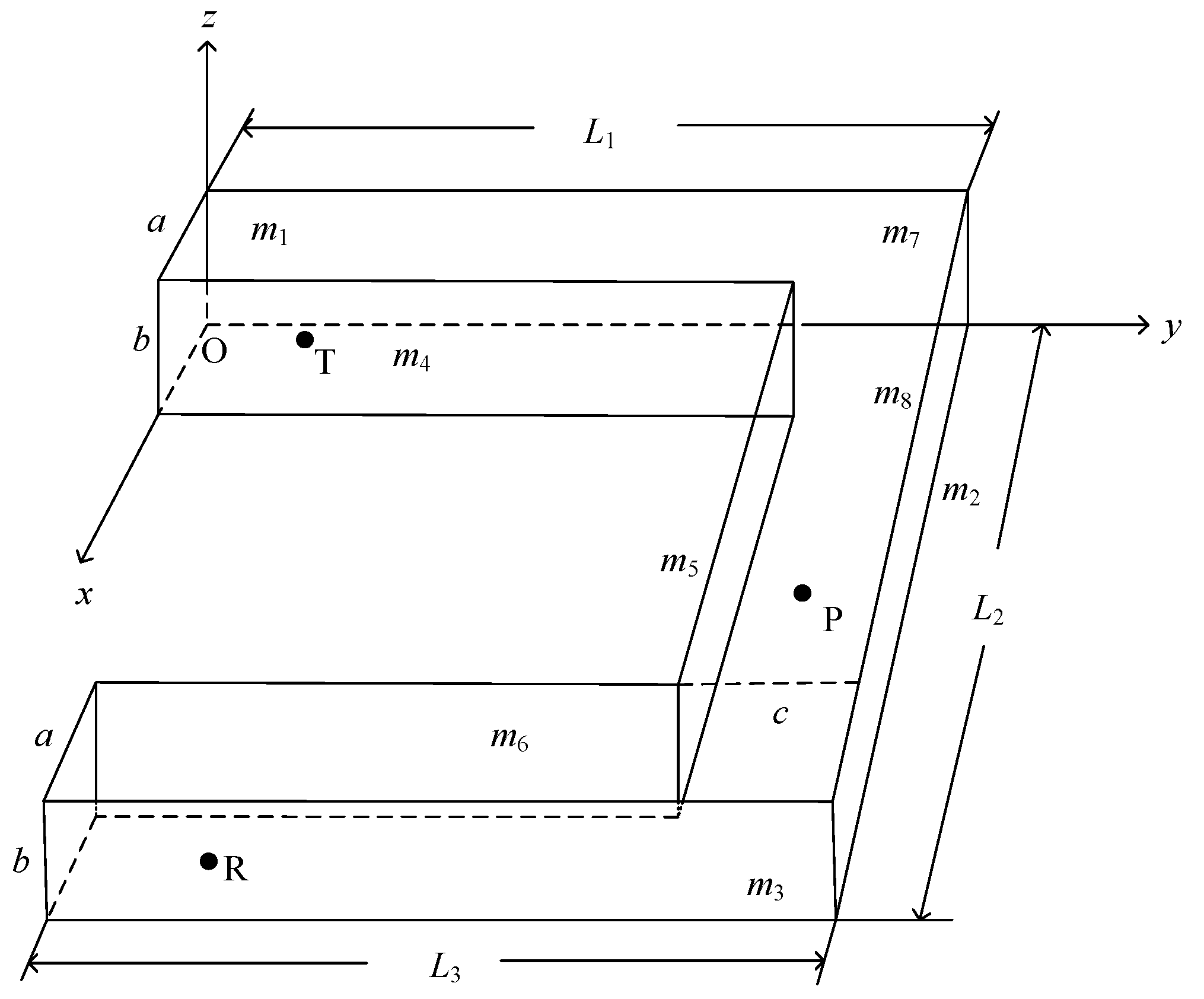


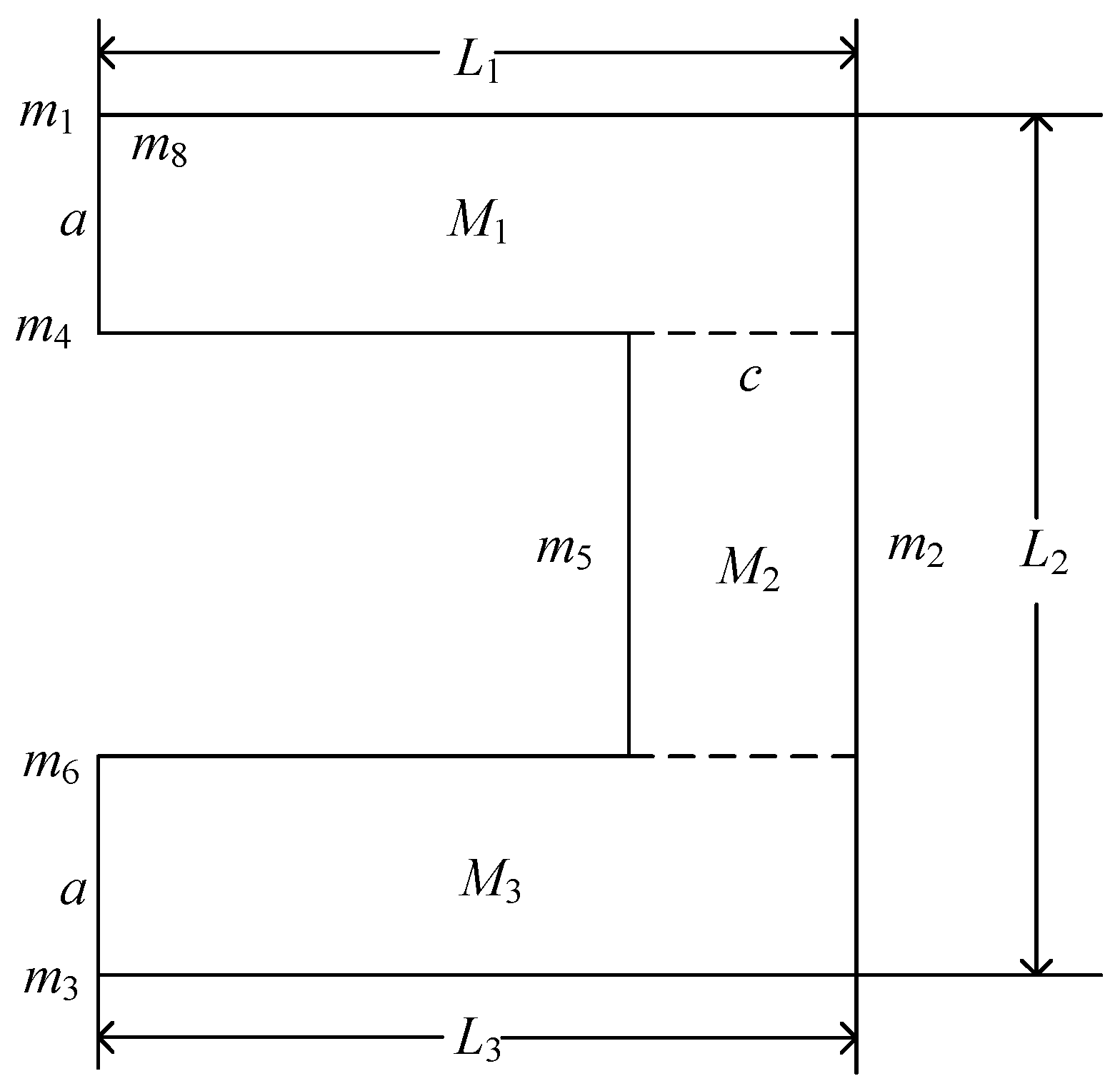


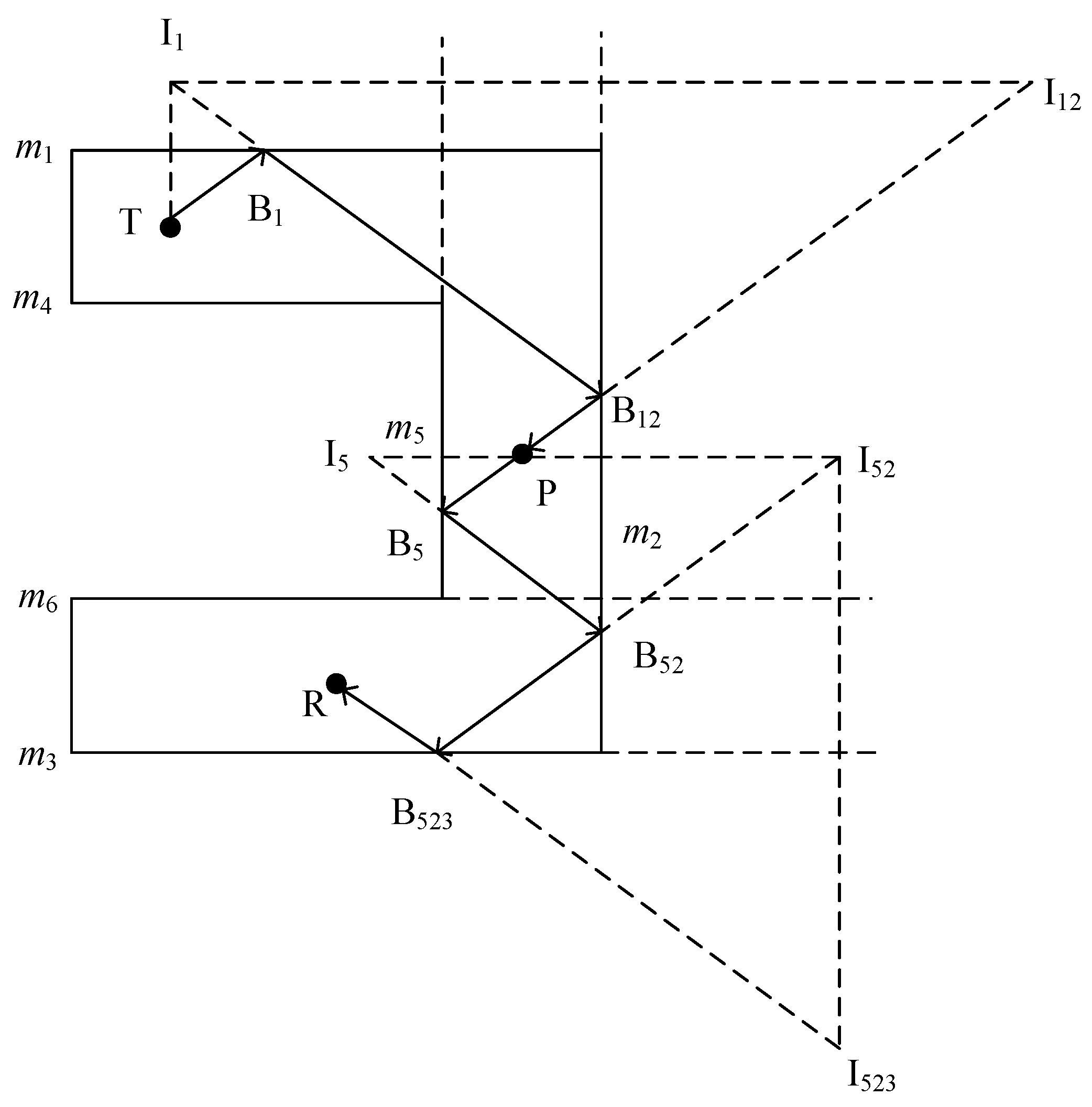

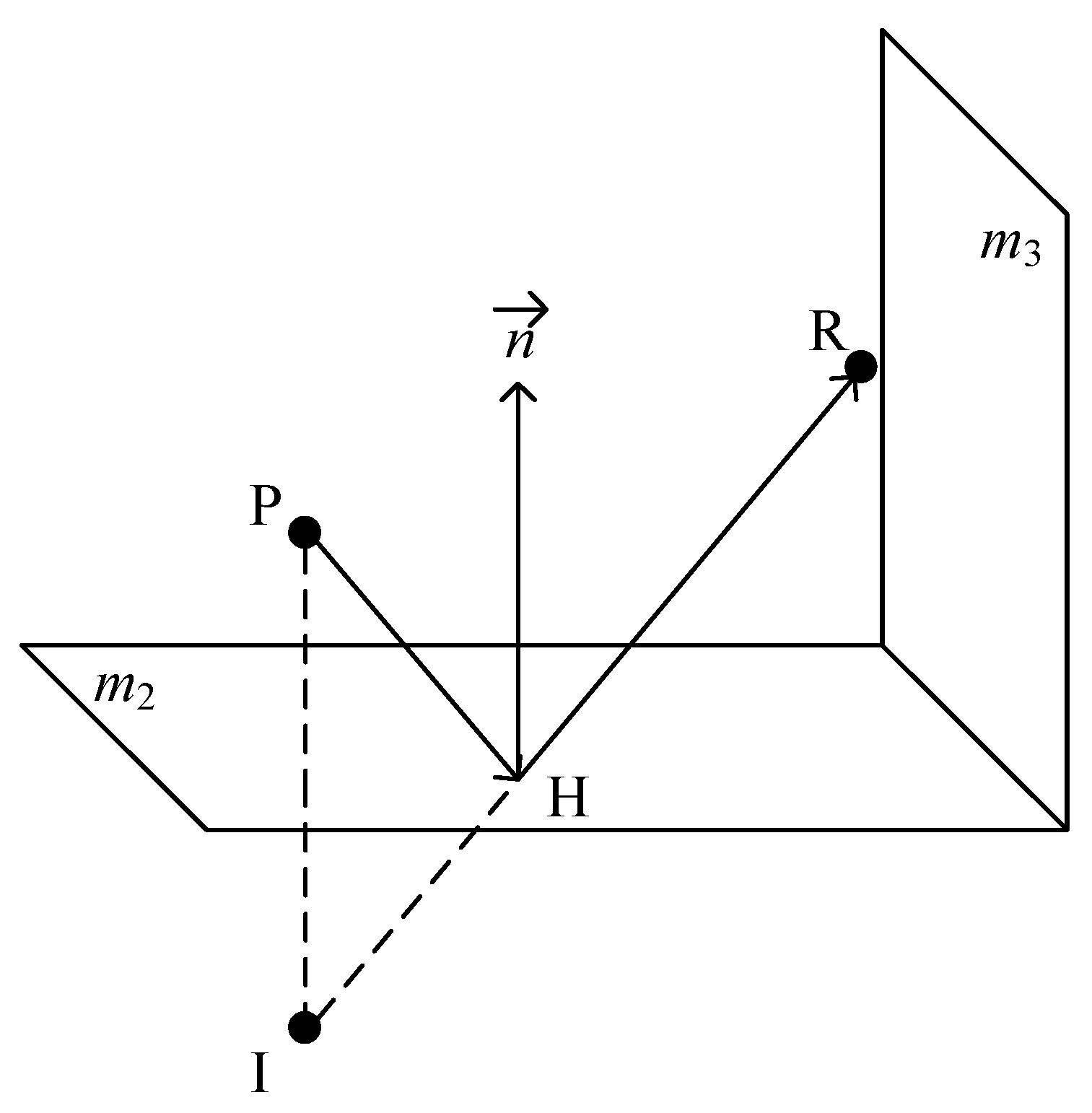
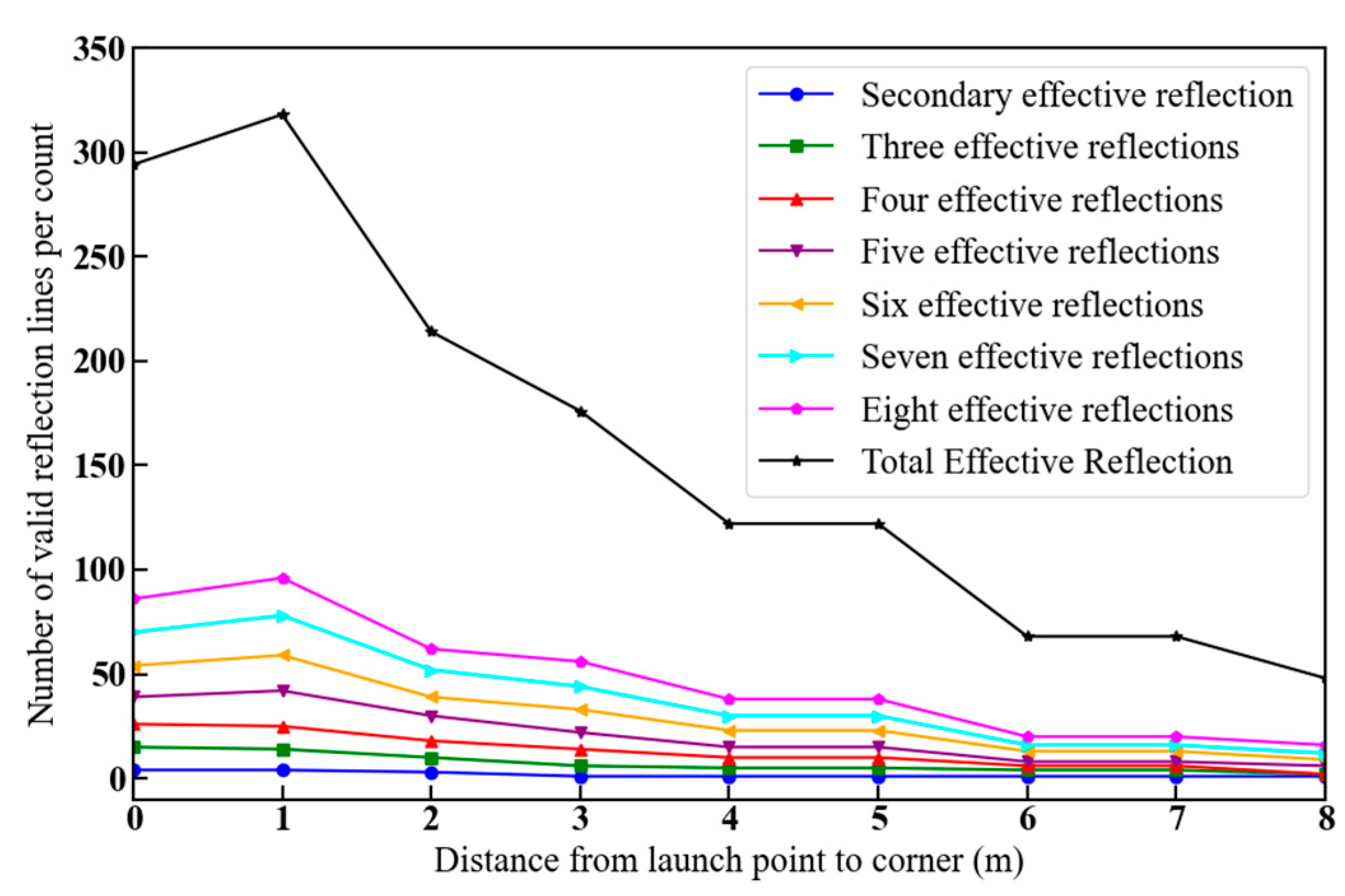
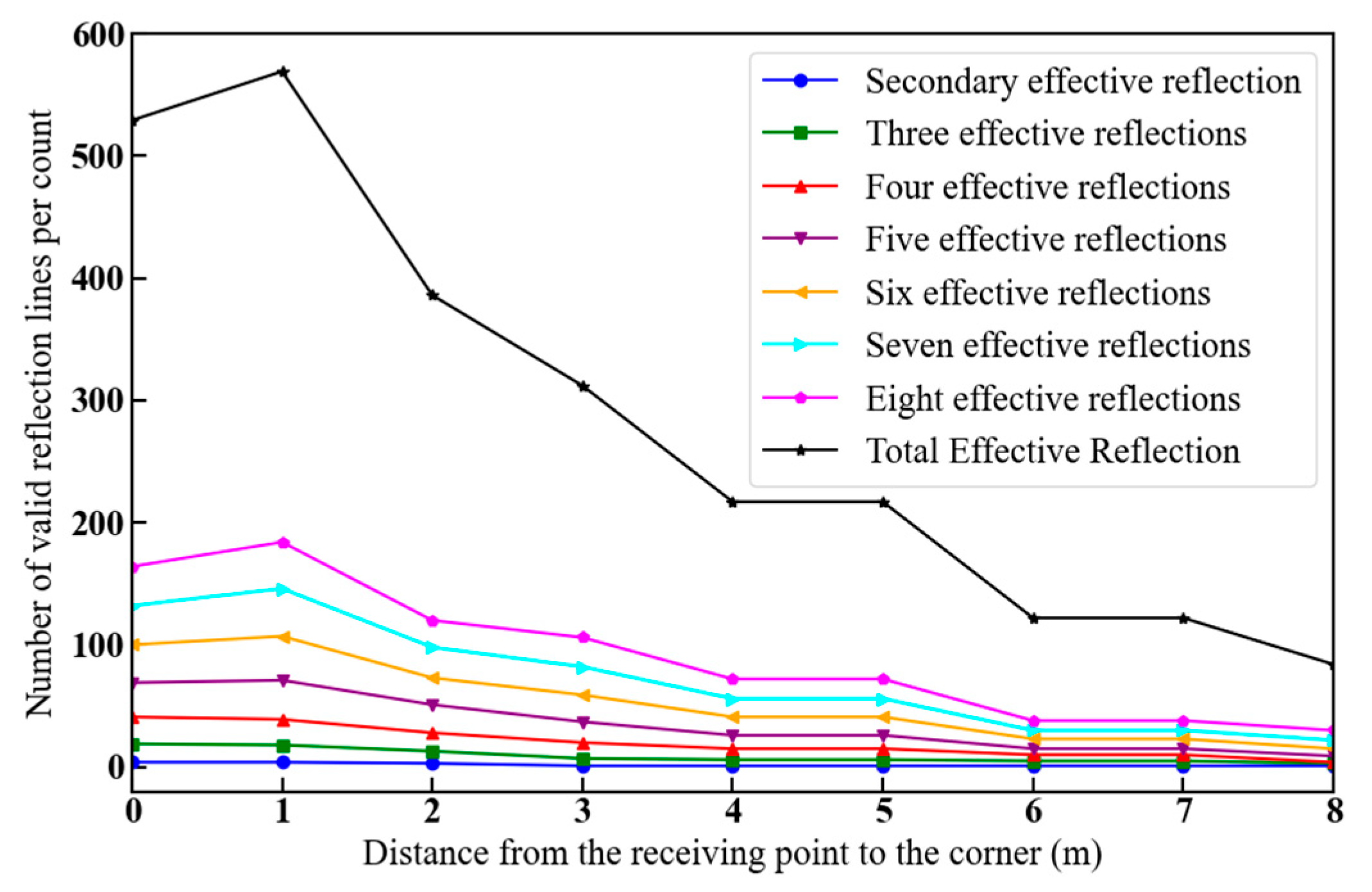
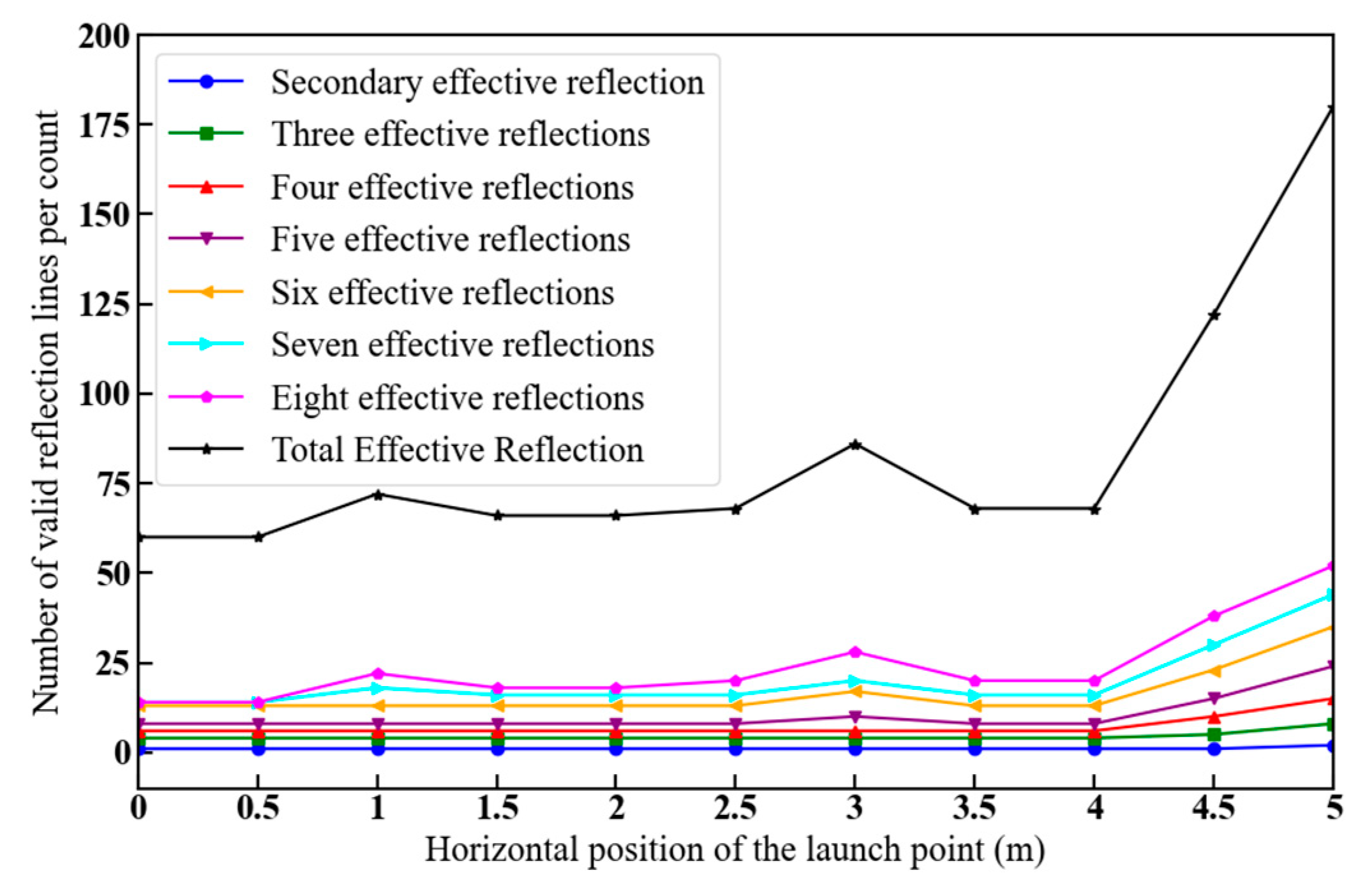
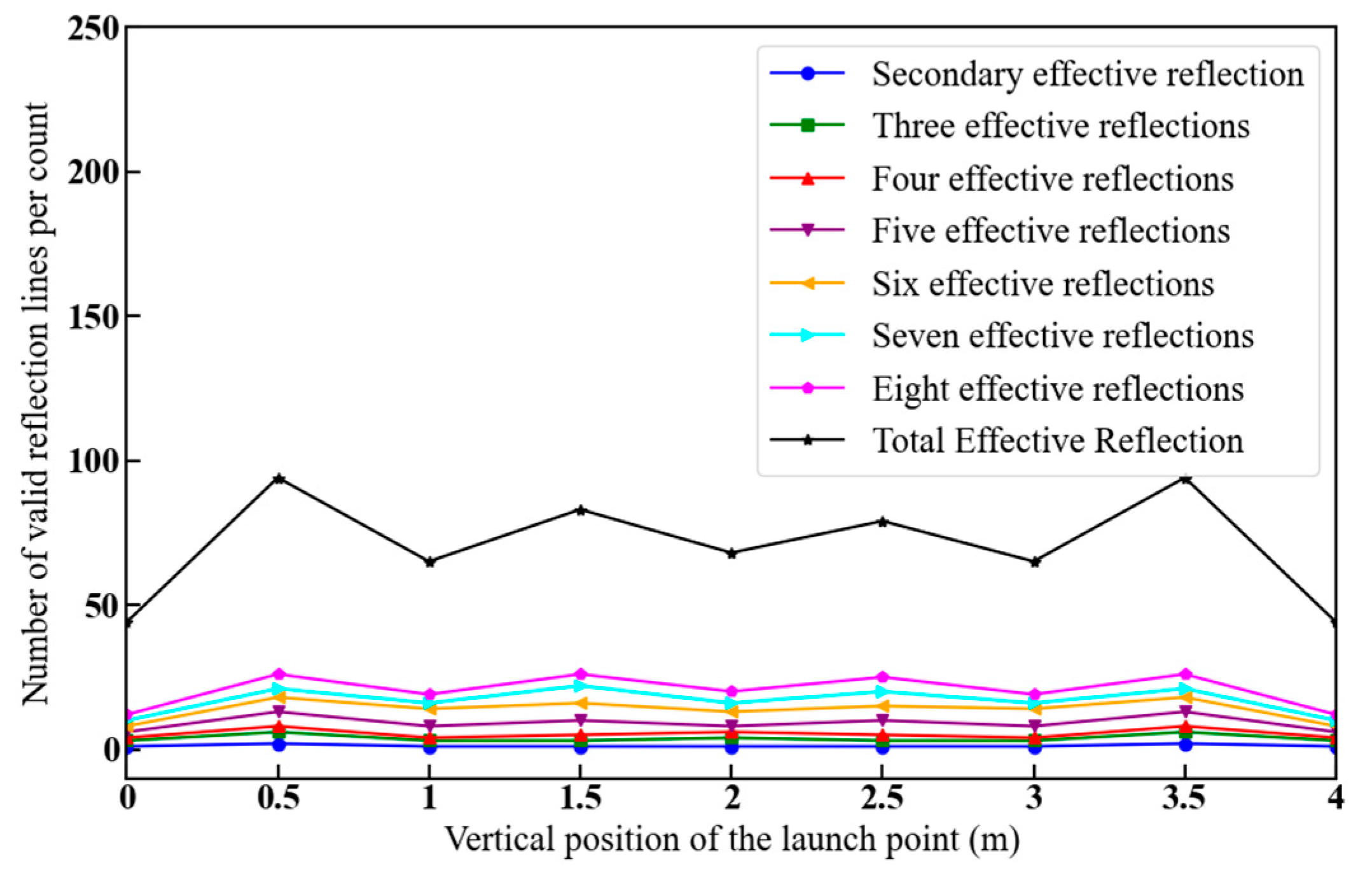

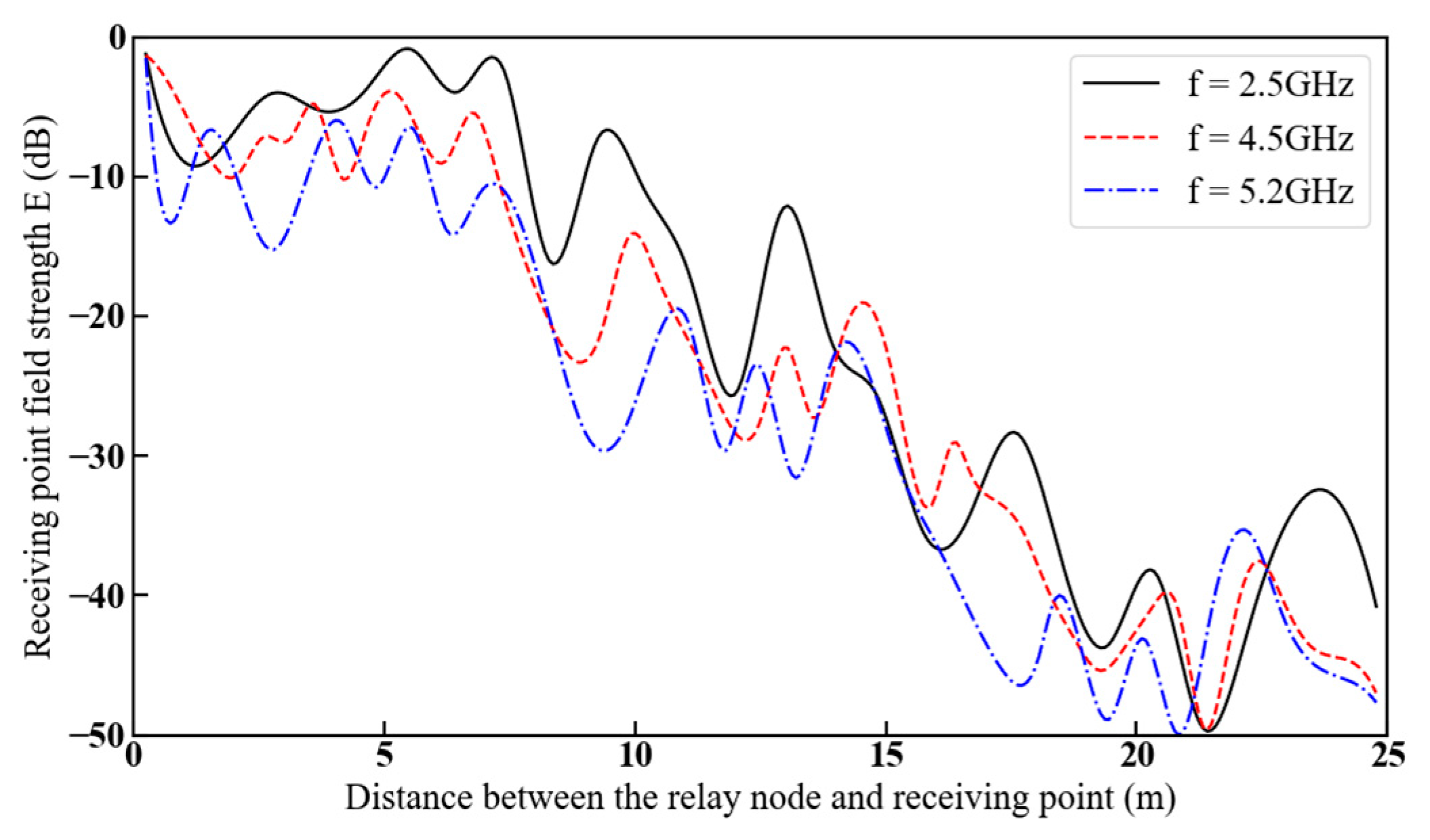
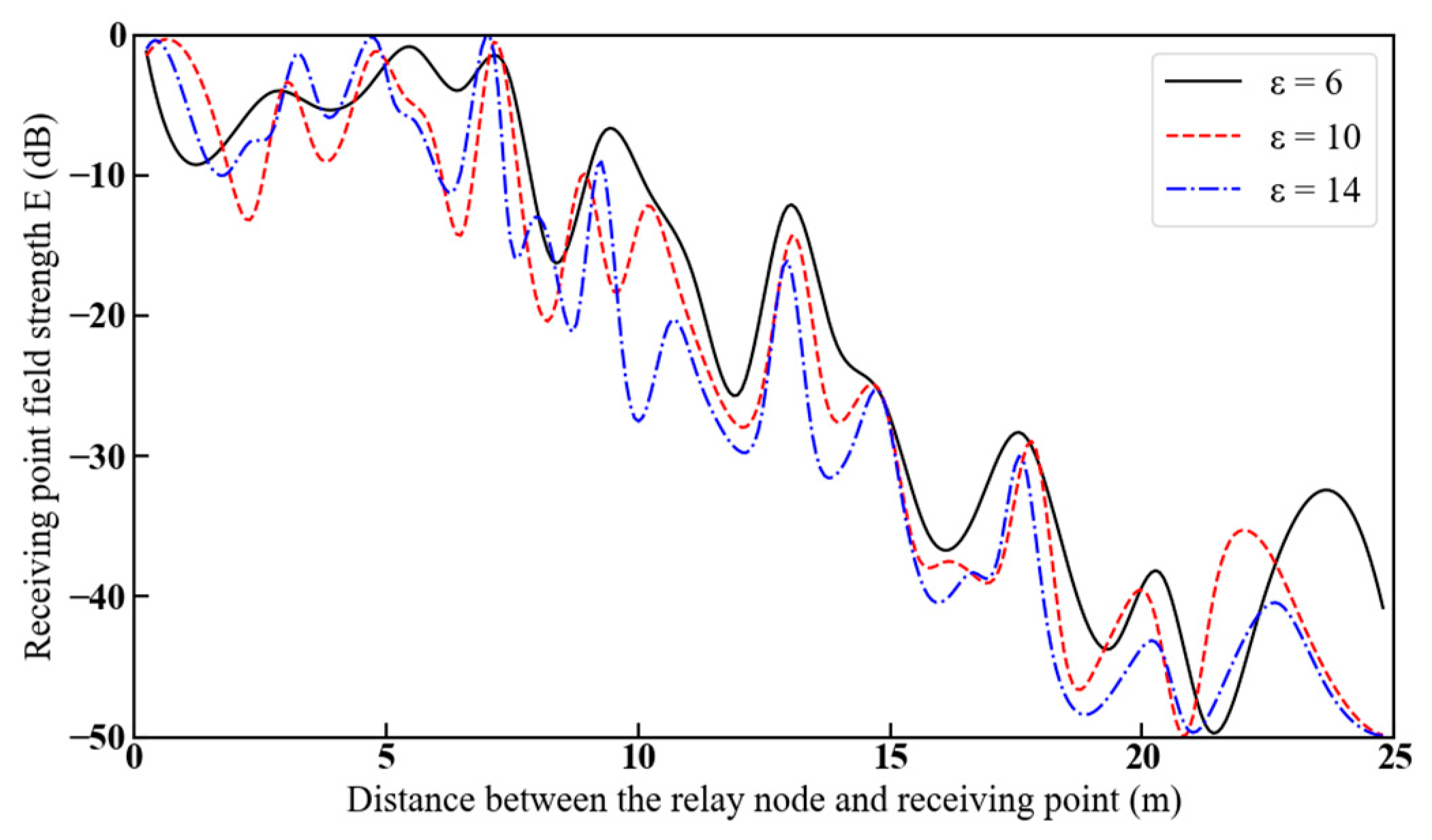
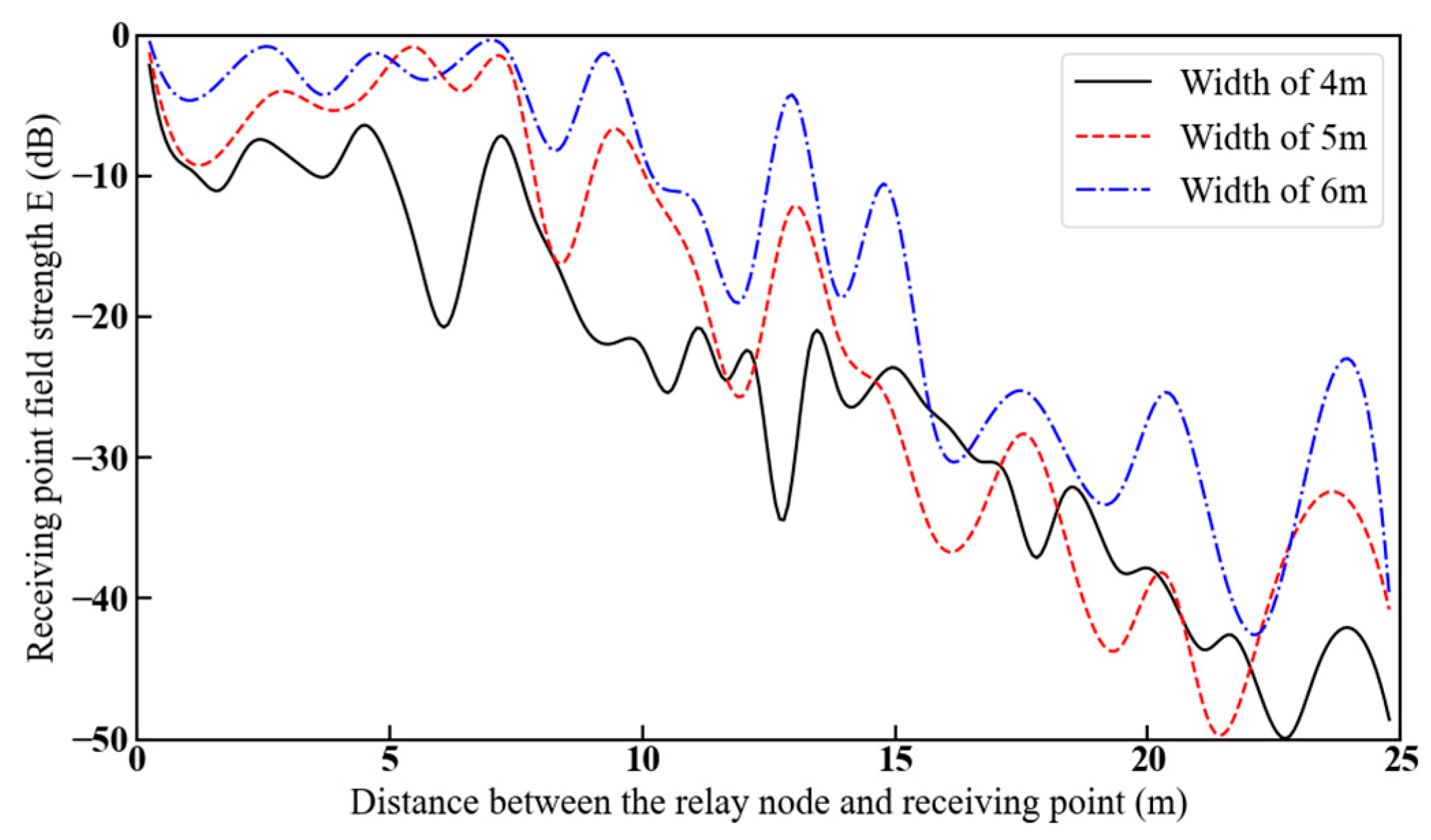


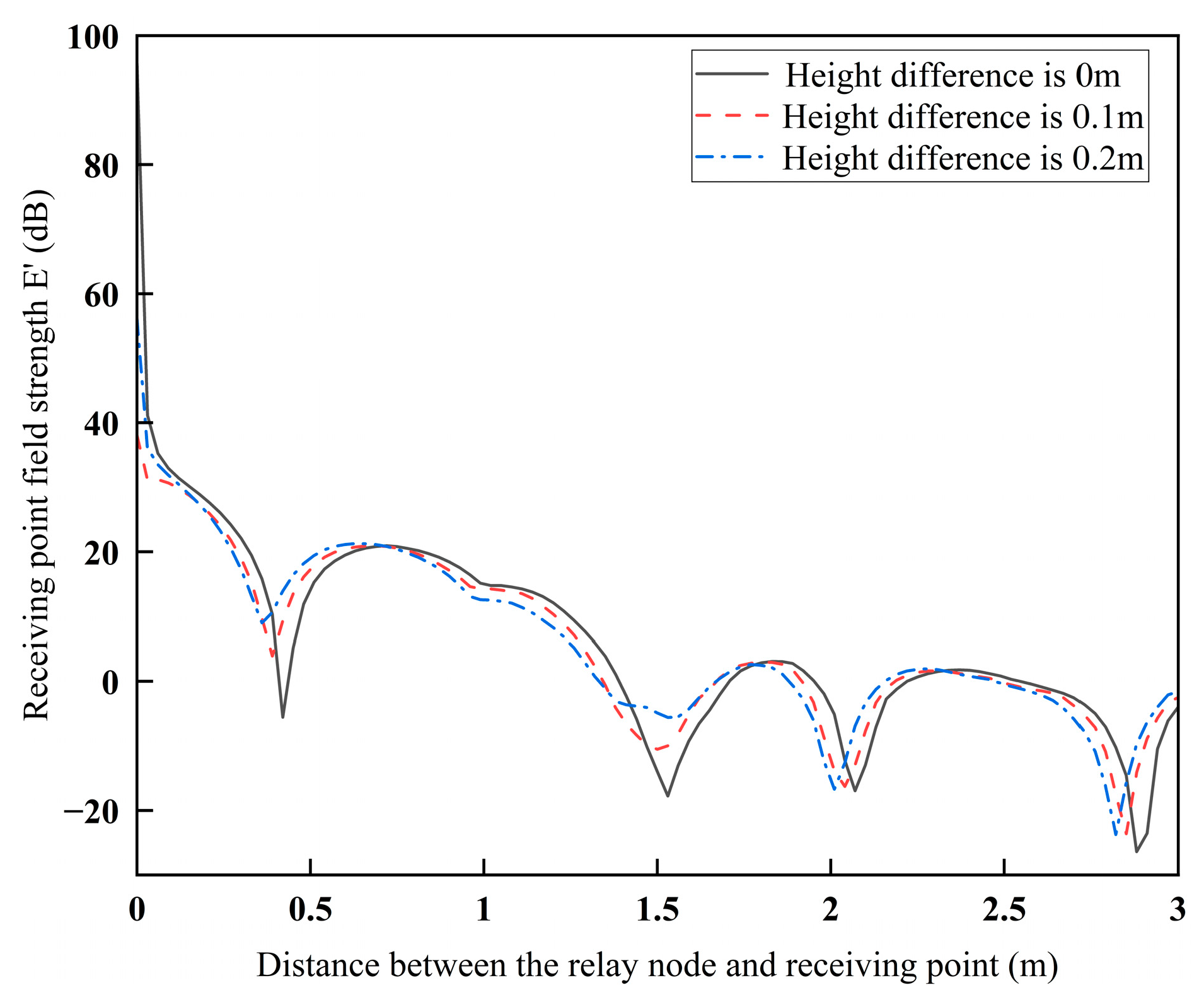
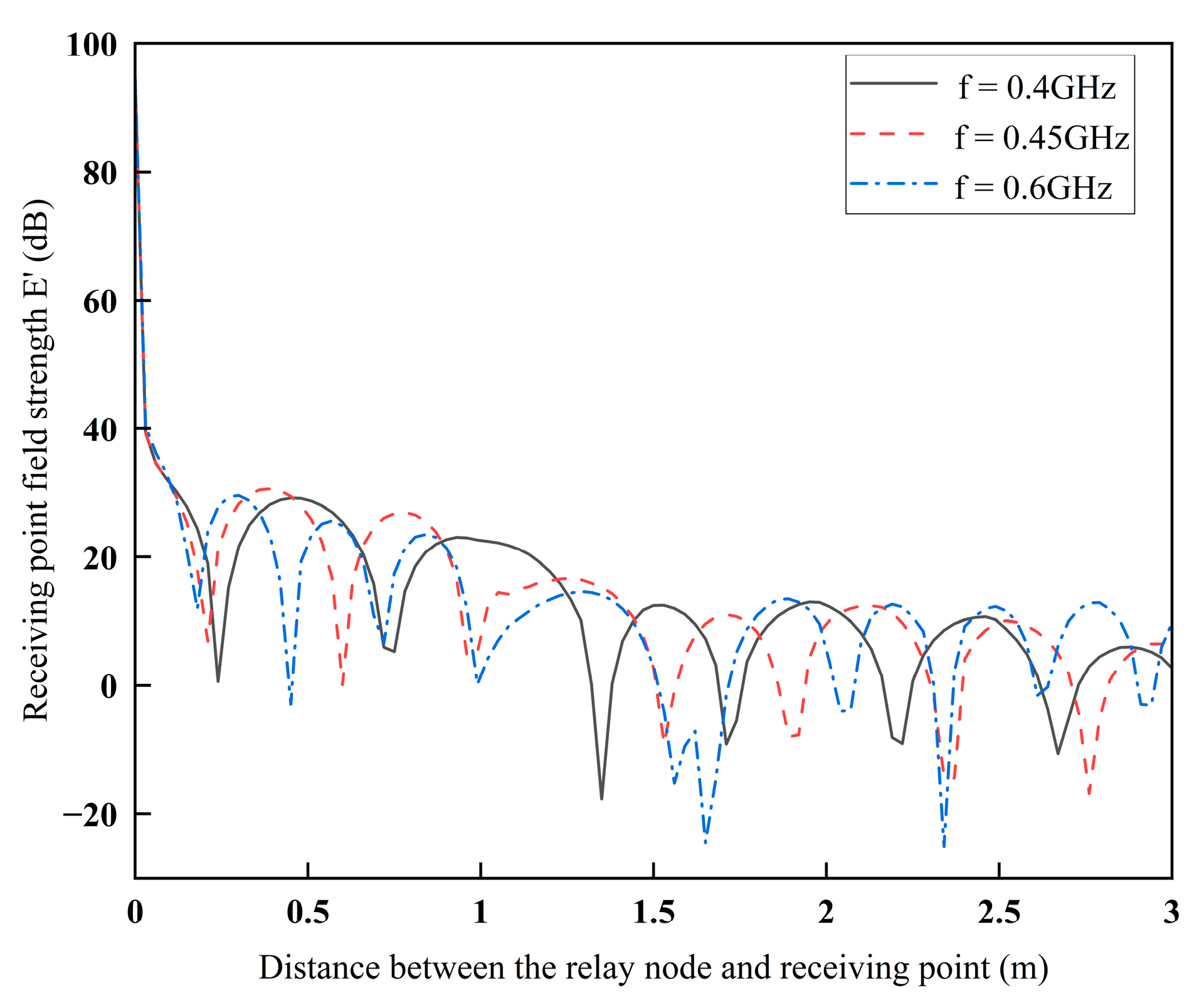
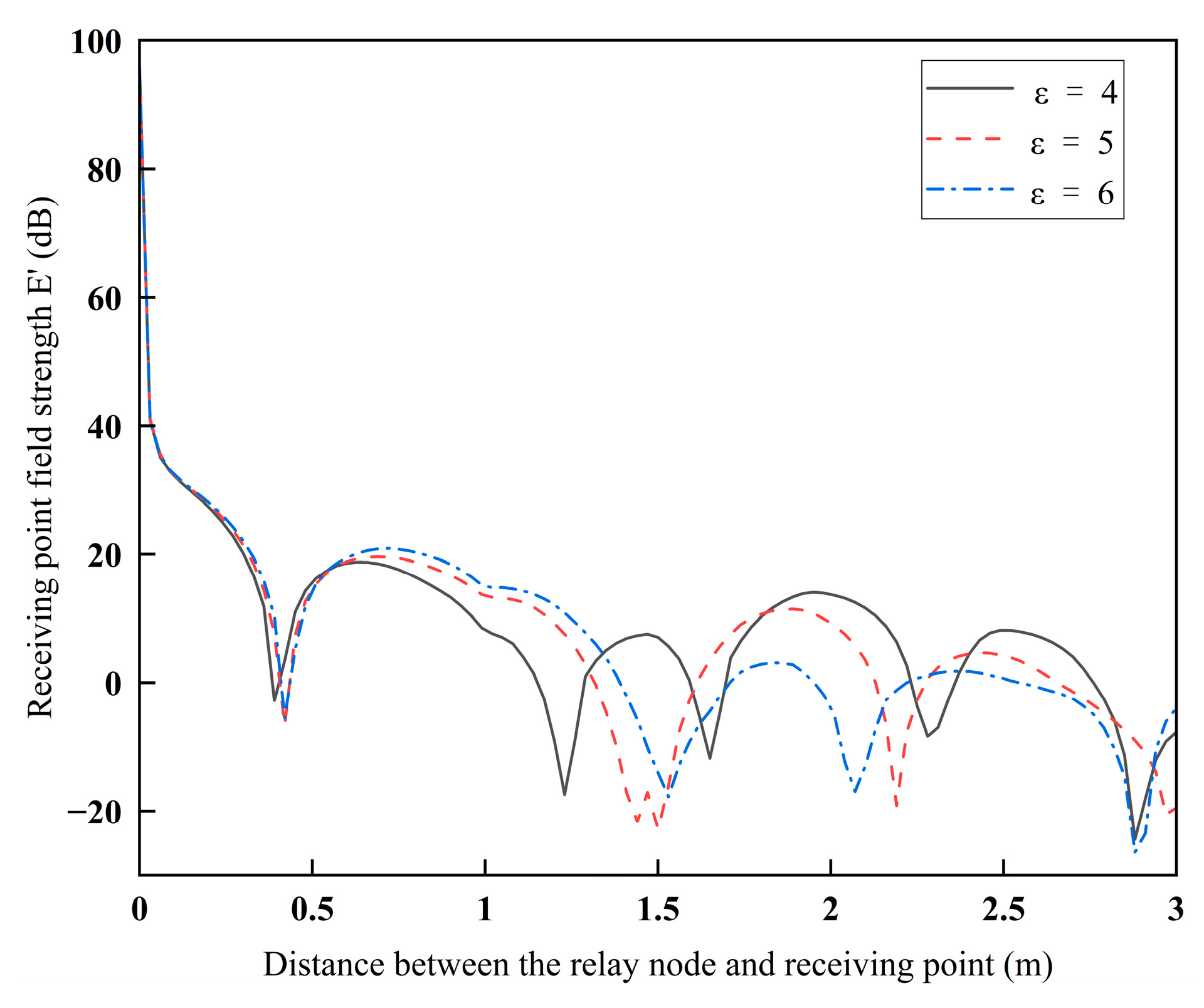
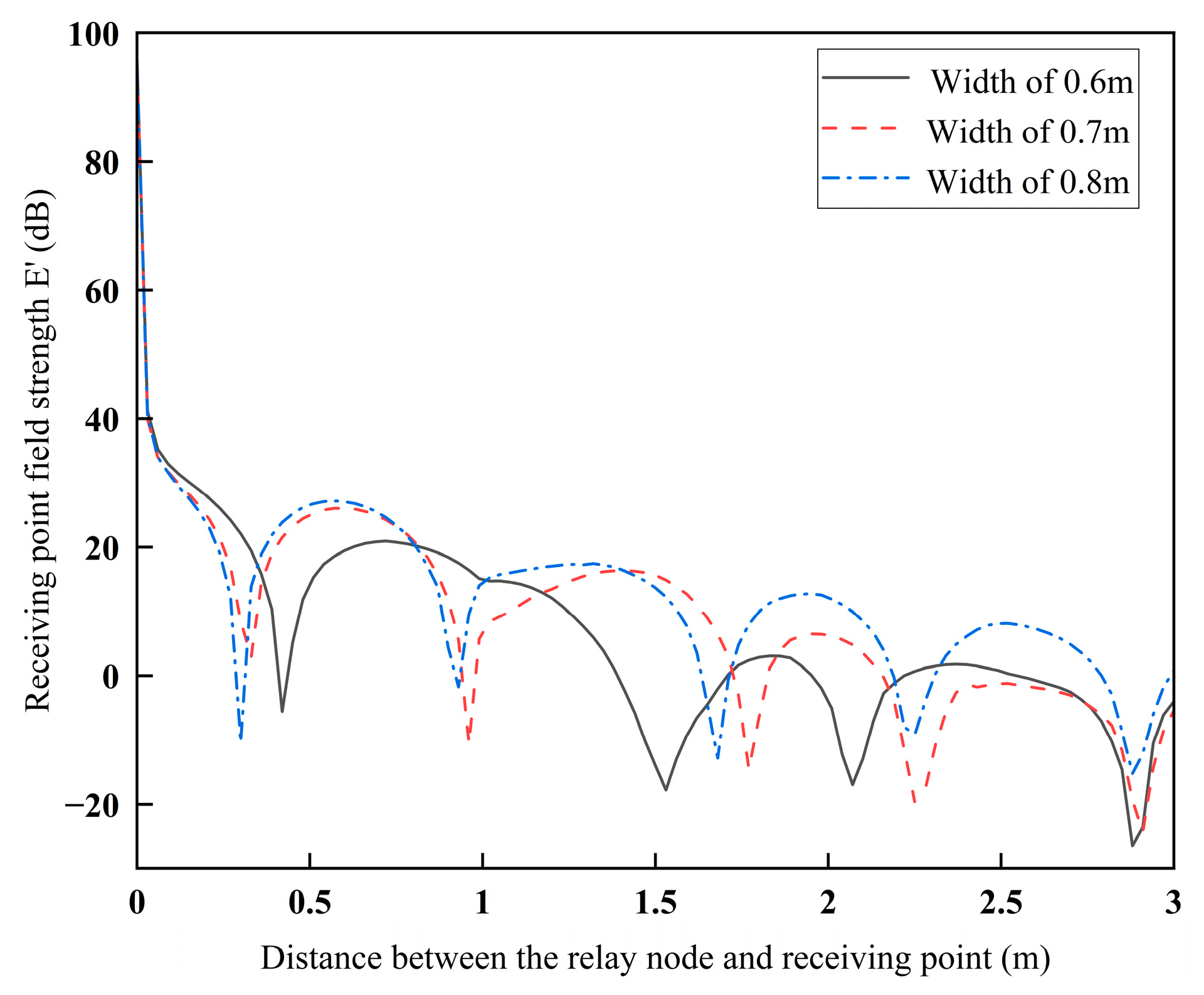
| Variable Definition | Variable Name | Variable Size (mm) |
|---|---|---|
| Operating wavelength | lambda | c/f |
| Total antenna length | length | 0.48 × lambda |
| Port distance | gap | 0.24 |
| Individual polaron length | dip_length | length/2–gap/2 |
| Radius of the antenna | dip_radius | lambda/200 |
| Parameter Name | Value |
|---|---|
| Transmission frequencies | 0.3 GHz, 0.4 GHz, 0.45 GHz, 0.6 GHz |
| Polarization mode | vertical polarization |
| Relative dielectric constants | 4, 5, 6 |
| Roadway widths | 0.6 m, 0.7 m, 0.8 m |
Disclaimer/Publisher’s Note: The statements, opinions and data contained in all publications are solely those of the individual author(s) and contributor(s) and not of MDPI and/or the editor(s). MDPI and/or the editor(s) disclaim responsibility for any injury to people or property resulting from any ideas, methods, instructions or products referred to in the content. |
© 2025 by the authors. Licensee MDPI, Basel, Switzerland. This article is an open access article distributed under the terms and conditions of the Creative Commons Attribution (CC BY) license (https://creativecommons.org/licenses/by/4.0/).
Share and Cite
Guo, L.; Li, X.; Shi, X.; Ma, L.; Guo, C. Reflection Propagation Law of Electromagnetic Waves in U-Shaped Roadway. Appl. Sci. 2025, 15, 1460. https://doi.org/10.3390/app15031460
Guo L, Li X, Shi X, Ma L, Guo C. Reflection Propagation Law of Electromagnetic Waves in U-Shaped Roadway. Applied Sciences. 2025; 15(3):1460. https://doi.org/10.3390/app15031460
Chicago/Turabian StyleGuo, Laigong, Xiaolong Li, Xinkang Shi, Long Ma, and Changna Guo. 2025. "Reflection Propagation Law of Electromagnetic Waves in U-Shaped Roadway" Applied Sciences 15, no. 3: 1460. https://doi.org/10.3390/app15031460
APA StyleGuo, L., Li, X., Shi, X., Ma, L., & Guo, C. (2025). Reflection Propagation Law of Electromagnetic Waves in U-Shaped Roadway. Applied Sciences, 15(3), 1460. https://doi.org/10.3390/app15031460






